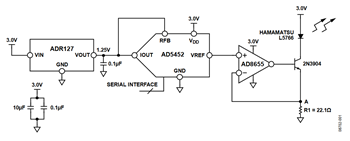AN-1212: Single Supply Low Noise LED Current Source Driver Using a Current Output DAC in the Reverse Mode
Circuit Function and Benefits
This circuit provides a low noise, single supply current drive for an LED. Each component is selected to operate from a 3.0 V single supply while maintaining very low peak-to-peak noise. The signal chain is optimized for low power, low noise optical communications and medical applications.
In a typical pulse oximetry application, an LED is pulsed from a high level of current (e.g., 3/4 scale) to a lower level of current (e.g., 1/4 scale). The on time of these pulses is typically in the order of several hundred microseconds. Peak-to-peak 1/f noise superimposed on the LED brightness levels during the on time affects the accuracy of the overall measurement. The R-2R core of a current output DAC has inherently low 0.1 Hz to 10 Hz noise because it is only the resistive noise of the ladder that causes the noise. The AD5452 current output DAC is used in the reverse mode so it can support single supply applications. By applying 1.25 V to the IOUT pin, a full-scale code will result in 1.25 V − 1 LSB appearing on the VREF pin, while a zero-scale code will result in 0 V on the VREF pin.
Key to maintaining low noise in the signal chain is the ADR127 reference, which has a 0.1 Hz to 10 Hz noise of only 9 µV p-p. In addition, the AD8655 is the industry’s lowest noise precision CMOS amplifier (1.23 µV p-p). The combined circuit has a typical 0.1 Hz to 10 Hz noise of only 14.7 µV p-p.
Circuit Description
| Product | Description |
| AD5452 | 12-bit multiplying DAC |
| AD8655 | Low noise precision CMOS amplifier |
| ADR127 | Low noise 1.25 V precision LDO |
The signal chain in Figure 1 shows the AD5452 current output DAC in reverse (voltage switching) mode controlling the brightness of an LED. By using the current output DAC in reverse mode, described in more detail in the AD5452 data sheet, the part can take a positive low noise 1.25 V reference input and output a positive 1.25 V – 1 LSB output at full-scale. It is important to note that with this configuration, the current output DAC is limited to low input voltages (<1.5 V) because the switches in the DAC ladder do not have the same source-to-drain drive voltage. As a result, their on-resistance differs, which degrades the integral linearity of the DAC. The ADR127 is a low noise 1.25 V output precision LDO and provides this low voltage. The ADR127’s high output current and low quiescent current make it ideal for handheld medical applications.
The 12-bit AD5452 DAC generates the voltage that drives the noninverting input of the operational amplifier. This voltage also appears across the R1 resistor, which should be a high precision resistor, and generates the current required at the collector of the bipolar transistor. Nominal diode current at full-scale is 56.6 mA for the circuit shown in Figure 1. A low noise AD8655 is used to sense the current through R1.
The R-2R architecture of the AD5452 allows for a very low noise DAC core. The dominating noise source in the signal chain is the ADR127 reference with a specified typical 1/f noise of 9 μV p-p. The plot in Figure 2 is the 0.1 Hz to 10 Hz voltage noise at the negative terminal of the AD8655, removing the noise added by the LED, in this case a Hamamatsu L5766. A standard 2N3904 NPN bipolar transistor was used in the circuit to drive the LED.
Common Variations
Other suitable DACs are the 16-bit single channel AD5543 or the 14-bit AD5446. Dual channel DACs will also work, such as the AD5447 (12-bit) and AD5545 (16-bit). The AD8656 is a dual channel version of the AD8655.
Alternative low noise precision op amps such as the ADA4841-1 and the ADA4841-2 are also suitable.
Learn More
Kester, Walt. The Data Conversion Handbook. Chapter 3, 7. Analog Devices. 2005.
MT-015 Tutorial, Basic DAC Architectures II: Binary DACs. Analog Devices.
MT-031 Tutorial, Grounding Data Converters and Solving the Mystery of AGND and DGND. Analog Devices.
MT-101 Tutorial, Decoupling Techniques. Analog Devices.
Voltage Reference Wizard Design Tool. Analog Devices

